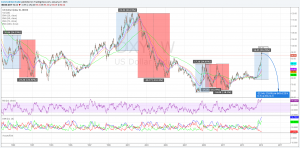Party like it’s 2009.
 Bullion.Directory precious metals analysis 4 June, 2015 By Christopher Lemieux Senior Analyst at Bullion.Directory; Twitter @Lemieux_26
Bullion.Directory precious metals analysis 4 June, 2015 By Christopher Lemieux Senior Analyst at Bullion.Directory; Twitter @Lemieux_26
The Fed has always claimed to be data-dependent. First, the potential for a rate hike was when unemployment dropped to 6.5 percent. That came and went as quickly as Americans dropped out of the workforce. Central bankers are no more than politicians. They will tell you what you want to hear, when you want to hear it.
Fed Chair Janet Yellen then stated that a “broader” approach to economic data would be taken, and as long as the economy was improving the likelihood of a rate increase. Only one problem – the data has been horrible. Forget mouthpiece economists, like DB’s Joe LaVorgna, who paints a “recovery” picture regardless of how bad the data is.
Before Janus Capital’s Bill Gross or DoubleLine’s Jeff Gruanloch, I been a firm believer that the Fed cannot normalize monetary policy because the multiple asset bubbles are derivative of their reckless quasi-monetary experiment, fathered by former Fed Chair Ben “there’s no housing bubble” Bernanke.
The modus operandi of the Fed is inflation, but the global economic climate is deflationary. It is interesting how all the developed nations, including China, has embarked on quantitative easing or other stimulus only to find inflation and consumption declining.
If the Fed needs inflation, they need a weaker dollar; and increasing interest rates would only strengthen it. The Fed has to prolong the rate hike because it prolongs the inevitable crash. If the Fed truly though the economy was strengthening and weakness was transitory, policy would have been on a path of normalization.
But the Fed is not the first to make this mistake. Forex traders remember that the Bank of England was really the first central bank the market looked to hike rates.
After the polar vortex in the US, the England was gaining some economic steam, and the Sterling rose much like the dollar did, reaching a high of 1.71 (GBPUSD). BoE Governor Mark Carney did not have the courage to tighten policy, and the Sterling collapsed. The good economic data points fell from the highs, much like in the US now.
The dollar’s decent is one of market participants loosing hope of a rate increase on the back of lackluster data with many data points at or approaching levels not seen during the Great Recession.
However, the paradox is that the dollar will likely remain elevated on a retaliative basis. I expect the DXY to have an 80-handle by mid-summer, but I do expect the dollar to rise again as the economic outlook darkens.
Consumer prices will likely to fall, and there is the potential for a brief period of deflation – like we saw in 2009. The Fed will have no choice but to enter the currency wars. A flashback to the dollar’s history following 20-plus percent gains:
 Bullion.Directory or anyone involved with Bullion.Directory will not accept any liability for loss or damage as a result of reliance on the information including data, quotes, charts and buy/sell signals contained within this website. Please be fully informed regarding the risks and costs associated with trading in precious metals. Bullion.Directory advises you to always consult with a qualified and registered specialist advisor before investing in precious metals.
Bullion.Directory or anyone involved with Bullion.Directory will not accept any liability for loss or damage as a result of reliance on the information including data, quotes, charts and buy/sell signals contained within this website. Please be fully informed regarding the risks and costs associated with trading in precious metals. Bullion.Directory advises you to always consult with a qualified and registered specialist advisor before investing in precious metals.











 Material provided on the Bullion.Directory website is strictly for informational purposes only. The content is developed from sources believed to be providing accurate information. No information on this website is intended as investment, tax or legal advice and must not be relied upon as such. Please consult legal or tax professionals for specific information regarding your individual situation. Precious metals carry risk and investors requiring advice should always consult a properly qualified advisor. Bullion.Directory, it's staff or affiliates do not accept any liability for loss, damages, or loss of profit resulting from readers investment decisions.
Material provided on the Bullion.Directory website is strictly for informational purposes only. The content is developed from sources believed to be providing accurate information. No information on this website is intended as investment, tax or legal advice and must not be relied upon as such. Please consult legal or tax professionals for specific information regarding your individual situation. Precious metals carry risk and investors requiring advice should always consult a properly qualified advisor. Bullion.Directory, it's staff or affiliates do not accept any liability for loss, damages, or loss of profit resulting from readers investment decisions.

Leave a Reply